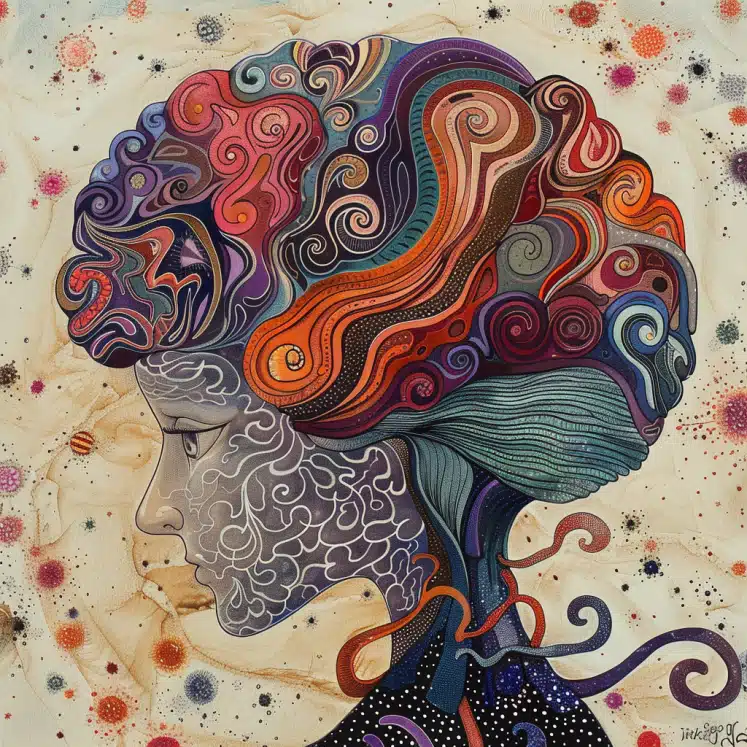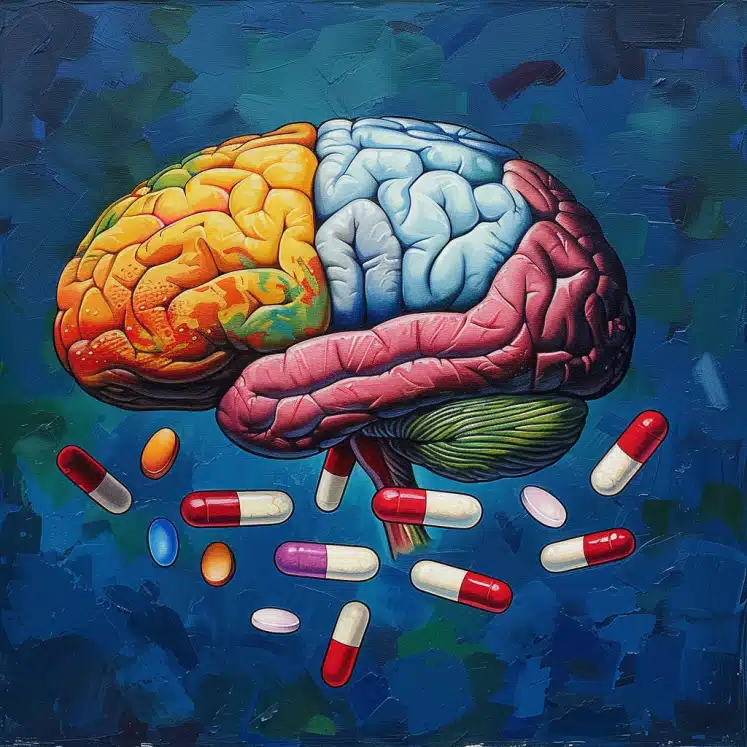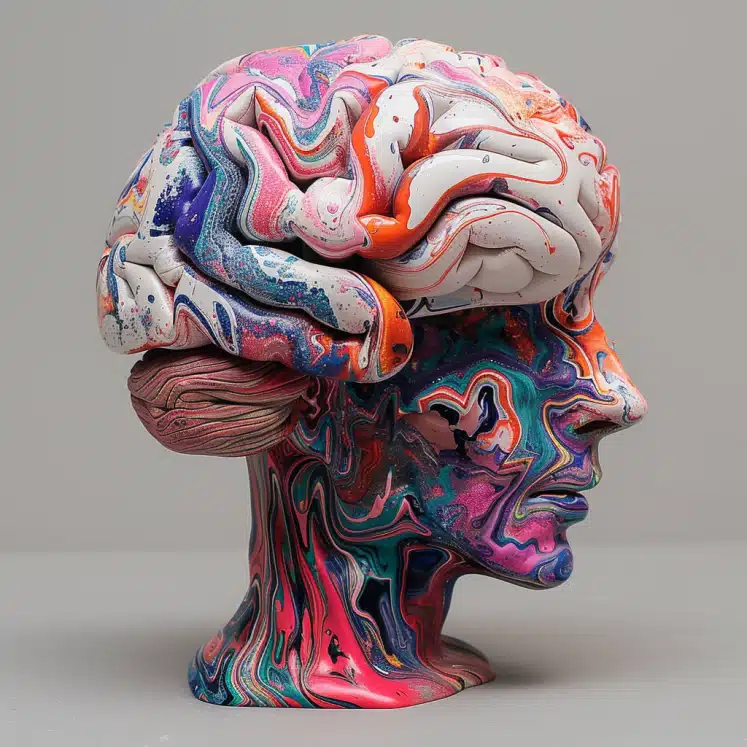Antidepressant treatment in OCD is linked to structural and functional brain changes, particularly in corticosubcortical areas, but these findings need further validation in larger, more homogeneous samples.
Highlights:
- Antidepressant Use: Antidepressants, especially SSRIs, are a primary treatment for OCD, resulting in significant brain changes.
- Brain Structure Changes: Studies show volume alterations in the thalamus, amygdala, pituitary gland, and putamen after antidepressant treatment.
- Functional Connectivity: Antidepressants were associated with changes in resting-state functional connectivity, particularly in the ventral striatum and various cortical regions.
- Imaging Techniques: Findings are based on structural MRI (sMRI), diffusion tensor imaging (DTI), and functional MRI (fMRI) studies.
Source: Psychiatry Research: Neuroimaging (2024)
Major Findings: Effects of Antidepressants on Brain Structure in OCD (2024)
1. Changes in Brain Volume
Antidepressant treatments, particularly selective serotonin reuptake inhibitors (SSRIs), have been associated with significant changes in the volume of various brain regions in individuals with obsessive-compulsive disorder (OCD).
- Thalamus: Studies have shown a decrease in thalamic volume after antidepressant treatment. The thalamus, a crucial part of the brain involved in sensory and motor signal relay, showed reduced volume following the use of SSRIs, indicating a potential normalization of overactive circuits in OCD.
- Amygdala: The amygdala, a region associated with emotion and fear processing, also exhibited volume reductions after treatment with antidepressants. This change is thought to be linked to the reduction of anxiety and fear responses commonly heightened in OCD.
- Pituitary Gland: An increase in pituitary gland volume was observed after antidepressant treatment, suggesting that these medications might affect hormone regulation systems tied to stress and mood.
- Putamen: Structural changes in the putamen, a part of the striatum involved in habit formation and motor skills, were noted, with increased volume in some cases. This might relate to the reduction of compulsive behaviors characteristic of OCD.
2. Alterations in Diffusion Metrics
Diffusion tensor imaging (DTI) studies have provided insights into microstructural changes in the brain following antidepressant treatment.
- Fractional Anisotropy (FA): Antidepressant use was associated with changes in FA, particularly in the corpus callosum and areas surrounding the striatum and thalamus. These changes indicate alterations in white matter integrity and connectivity, which might underlie improved cognitive and emotional regulation in treated patients.
- Mean and Radial Diffusivity (MD and RD): Decreases in MD and RD were observed in regions like the right midbrain and left striatum. These reductions suggest improvements in the microstructural integrity of these regions, potentially leading to better functional outcomes for individuals with OCD.
3. Functional Connectivity Changes
Functional MRI (fMRI) studies highlighted significant changes in resting-state functional connectivity (rs-FC) after antidepressant treatment.
- Ventral Striatum: Increased connectivity between the ventral striatum and frontal cortical regions was observed, suggesting improved communication between areas involved in reward processing and executive function. This may help in reducing compulsive behaviors and improving decision-making processes.
- Frontal and Prefrontal Cortex: Enhanced connectivity within the frontal and prefrontal cortex regions was noted, which are crucial for planning, decision-making, and behavioral control. These changes likely contribute to better management of OCD symptoms.
- Default Mode Network (DMN): Alterations in the DMN, responsible for self-referential thinking and mind-wandering, were found. Improved connectivity within this network may help reduce the excessive and intrusive thoughts that are typical in OCD.
4. Limitations & Need for Further Research
While these findings are promising, several limitations must be addressed for a comprehensive understanding.
- Sample Size & Homogeneity: The studies included in this review had small sample sizes and varied significantly in terms of patient demographics and treatment protocols, which can affect the reliability and generalizability of the results.
- Duration of Follow-Up: Many studies had short follow-up periods, which might not capture long-term effects of antidepressant treatment on brain structure and function.
- Methodological Variability: Differences in imaging techniques, analysis methods, and regions of interest across studies complicate the comparison and synthesis of findings.
Study Overview: Neuroimaging of OCD Brains on Antidepressants (2024)

The study aimed to explore the effects of antidepressants on neuroimaging findings in individuals with obsessive-compulsive disorder (OCD) to better understand the brain mechanisms underlying the clinical efficacy of these medications.
Sample
- Studies Reviewed: 13 neuroimaging investigations.
- Participants: A total of 261 patients with OCD and 219 healthy controls.
- Ages: Included both pediatric and adult OCD patients.
- Medications: Primarily selective serotonin reuptake inhibitors (SSRIs) such as paroxetine, fluoxetine, fluvoxamine, sertraline, and citalopram, along with other antidepressants like clomipramine and serotonin-norepinephrine reuptake inhibitors (SNRIs).
Methods
- Data Sources: Systematic search conducted on PubMed, Scopus, Embase, and Web of Science.
- Inclusion Criteria: Studies assessing the effects of antidepressants in patients with OCD using MRI, fMRI, or DTI.
- Exclusion Criteria: Reviews, meta-analyses, letters, case reports, case series, pre-print articles, conference abstracts, and studies with concurrent therapies.
- Neuroimaging Techniques: Structural Magnetic Resonance Imaging (sMRI). Diffusion Tensor Imaging (DTI). Functional Magnetic Resonance Imaging (fMRI).
- Outcome Measures: Changes in brain volume, diffusion metrics, and functional connectivity.
Limitations
- Sample Size: Small number of studies and participants, which may affect the statistical power and generalizability of the results.
- Heterogeneity: Variability in patient demographics, treatment protocols, duration of follow-up, and imaging methodologies.
- Methodological Differences: Differences in study design, imaging techniques, and analysis methods limit the ability to compare and synthesize findings across studies.
- Short Follow-Up Periods: Many studies had relatively short follow-up durations, potentially missing long-term effects of antidepressant treatment.
Conclusion: Antidepressants vs. OCD Brains
This study highlights the significant impact of antidepressant treatment on the brain structure and function of individuals with obsessive-compulsive disorder (OCD).
Antidepressants, particularly SSRIs, are associated with notable changes in key brain regions, including the thalamus, amygdala, pituitary gland, and striatum, as well as alterations in functional connectivity within crucial neural circuits.
These changes likely reflect the normalization of overactive brain pathways implicated in OCD, leading to symptom relief.
While similar brain alterations are seen in other conditions treated with antidepressants, the specific involvement of the cortico-striato-thalamo-cortical (CSTC) circuit in OCD underscores the unique interaction between these medications and OCD pathology.
However, the variability in study methodologies, small sample sizes, and heterogeneous patient populations indicate a need for further research to validate these findings.
Larger, more standardized studies are essential to deepen our understanding of the brain mechanisms underlying the efficacy of antidepressants in treating OCD and to explore the potential differential effects based on OCD subtypes.
References
- Study: Effects of antidepressants on brain structure and function in patients with obsessive-compulsive disorder: A review of neuroimaging studies (2024)
- Authors: Homa Seyedmirzaei et al.








